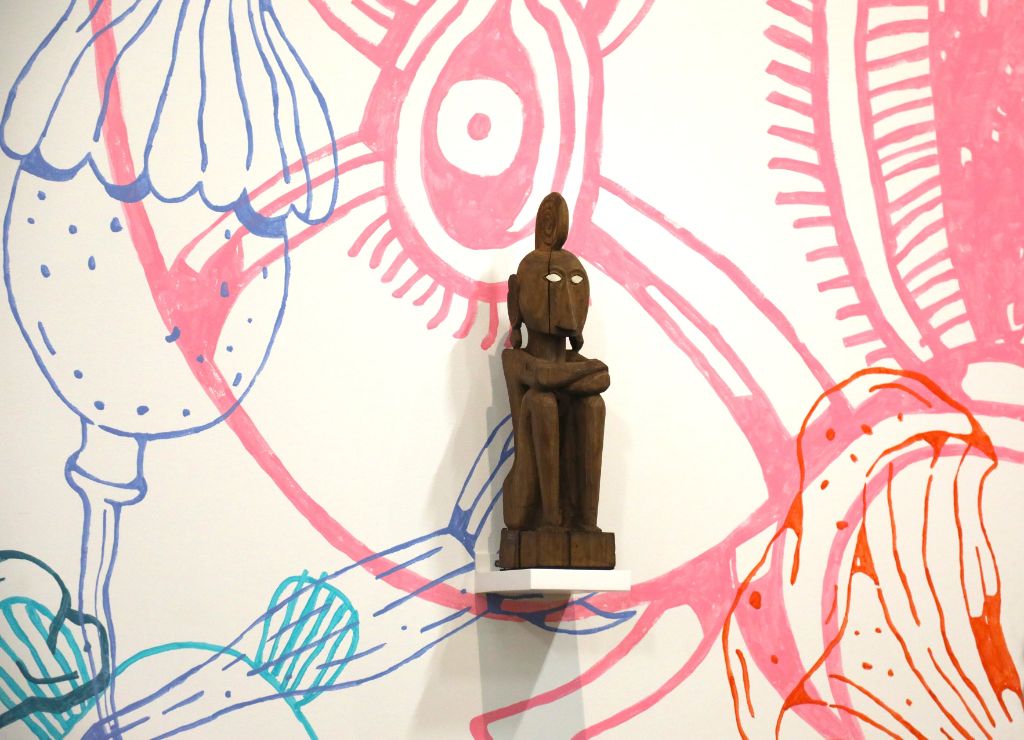See you on the other side
Artist Eddie Hara regularly collaborates with the MKB. He has painted a mural for the upcoming exhibition “The path to the beyond” and will tell us more about it.
It covers almost one entire wall of the exhibition space. Huge whimsical figures populate the mural. They are somewhat of a trademark for Eddie Hara. They are reminiscent of comic book characters, street art and extraterrestrial beings.
Eddie Hara is used to painting high up
Perhaps this time less extraterrestrial than otherworldly. Because the work is called “See you on the other side”. It is part of the exhibition “The path to the beyond” and an answer to a question that preoccupies both the exhibition and Hara: What comes after death?
A world full of pleasure
The Indonesian artist, who has done projects with and for the MKB since 1996, emphasises that this is his view as a contemporary artist, not his personal one. He sees the other side as something pleasant. He imagines a world where people have free choice, a world full of pleasure.
Hara likes cultures that deal with death and remembrance in a cheerful way, and he expresses this in his painting. The mural is rather cheerful, indeed. The fantastical figures convey a playful mood.
The ancestors's face boho-na-bwete from the Kota-Mahongwe from Gabun, dating back to before 1955, seems to merge with the mural
However, the theme of death is present, in the skulls for example. And contrary to his other murals, where he prefers bright colours, this work of Hara is wrapped in delicate pastel colours.
With a playful mind
Adding an ironic and humorous touch to his work – which he is known for – fits in well with the exhibition, which will be anything but gloomy and which visually advertises itself with a skeleton in a toy car. “There has to be a bit of mystery in it”, says the artist, “but it shouldn't frighten us. We should look at it like children do, with a playful mind.”
The Luha-Mask hantu rayo (Big Spirit) from Kudangan, South-West-Kalimantan in Indonesia, dating back to before 1934, is carefully installed in the designated location
If we do, we discover three objects from the MKB collection, standing on small pedestals on the wall. They almost disappear though into the mural. This is intentional. They are meant to be part of the painting. And they are, even in two ways, because their huge portraits smile at the viewers.
Visually appealing objects
They are an Indonesian mask, an Indonesian ancestor’s figure and an ancestor's face from Gabun. Like the painted figures, they show that the path to the afterlife is pleasant, peaceful, perhaps a little scary and sad at times – when you have to say goodbye to loved ones – but always exciting and fun.
Why did Hara choose these three in particular? Because they appealed to him visually.

The ancestry figure from Babar, Indonesia, from the first half of the 20th century, is looking stoically into the room, while a wild world is being created behind it
The artist painted them and other figures in small format on transparent paper and then projected them onto the wall in huge size. He opted for graphics. A few figures are copies of existing works.
An honour
As he looks at his almost finished work on a hot day in July, he muses: “I hope that dying is the beginning of a new life, a life on the other side.” He continues: “Dying should be peaceful, scary, fun and exciting – like my mural. Of course, there should also be room for tradition.”
He emphasises that it is an honour for him to paint a mural for the MKB. And he expresses a “last” wish for the world beyond, hinting to the current state of the world: “Be free. Be free from hate!”